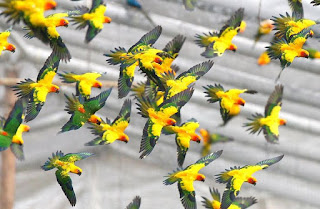The
cockatiel (
Nymphicus hollandicus), also known as the quarrion and the weiro, is a bird that is

a member of the cockatoo family endemic to Australia. They are prized as household pets and companion parrots throughout the world and are relatively easy to breed. As a caged bird, cockatiels are second in popularity only to the budgerigar.
The cockatiel is the only member of the genus
Nymphicus.
It was previously considered a crested parrot or small cockatoo;
however, more recent molecular studies have assigned it to its own
subfamily,
Nymphicinae. It is, therefore, now classified as the smallest of the Cacatuidae (cockatoo family). Cockatiels are native to Australia, and favour the Australian wetlands, scrublands, and bush lands.
Sexual dimorphism

All
wild cockatiel chicks and juveniles look female, and are virtually ~
indistinguishable from the time of hatching until their first moulting. They display horizontal yellow stripes or bars on the ventral
surface of their tail feathers, yellow spots on the ventral surface of
the primary flight feathers of their wings, a grey coloured crest and
face, and a dull orange patch on each of their cheeks.
Adult cockatiels are sexually dimorphic,
though to a lesser degree than many other avian species. This is only
evident after the first moulting, typically occurring about six to nine
months after hatching: the male loses the white or yellow barring and
spots on the underside of his tail feathers and wings. The grey feathers
on his cheeks and crest are replaced by bright yellow feathers, while
the orange cheek patch becomes brighter and more distinct. The face and
crest of the female will typically remain mostly grey, though also with
an orange cheek patch. Additionally, the female commonly retains the
horizontal barring on the underside of her tail feathers.
The colour in cockatiels is derived from two pigments: melanin (which provides the grey colour in the feathers, eyes, beak, and feet), and lipochromes
(which provide the yellow colour on the face and tail and the orange
colour of the cheek patch). The grey colour of the melanin overrides the
yellow and orange of the lipochromes when both are present.

The melanin content decreases in the face of the males as they
mature, allowing the yellow and orange lipochromes to be more visible,
while an increase in melanin content in the tail causes the
disappearance of the horizontal yellow tail bars.
In addition to these visible characteristics, the vocalization of
adult males is typically louder and more complex than that of females.
 The Andean cock-of-the-rock exhibits marked sexual dimorphism;
the male has a large disk-like crest and scarlet or brilliant orange
plumage, while the female is significantly darker and browner.
Gatherings of males compete for breeding females with each male
displaying its colourful plumage, bobbing and hopping, and making a
variety of calls. After mating, the female makes a nest under a rocky
overhang, incubates the eggs, and rears the young, all by herself.
The Andean cock-of-the-rock exhibits marked sexual dimorphism;
the male has a large disk-like crest and scarlet or brilliant orange
plumage, while the female is significantly darker and browner.
Gatherings of males compete for breeding females with each male
displaying its colourful plumage, bobbing and hopping, and making a
variety of calls. After mating, the female makes a nest under a rocky
overhang, incubates the eggs, and rears the young, all by herself. The Andean cock-of-the-rock eats a diet of fruit, supplemented by
insects, amphibians, reptiles, and smaller mice. It is distributed all
across the cloud forest of the Andes, having a range of around
260,000 km2 (100,000 sq mi). Even though it is being affected
by destruction of its habitat, the Andean cock-of-the-rock is not
classified as threatened.
The Andean cock-of-the-rock eats a diet of fruit, supplemented by
insects, amphibians, reptiles, and smaller mice. It is distributed all
across the cloud forest of the Andes, having a range of around
260,000 km2 (100,000 sq mi). Even though it is being affected
by destruction of its habitat, the Andean cock-of-the-rock is not
classified as threatened.













